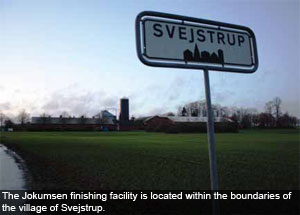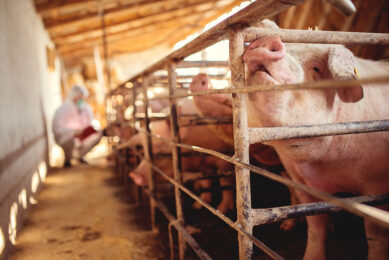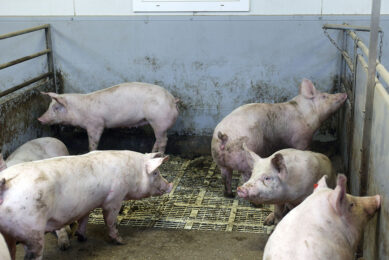Trying not to bother the neighbours

Having a pig production site in the close vicinity of a village may cause some trouble, wherever you are in the world, due to unwanted odours. In Denmark, tight emission legislation makes the situation even more difficult. No wonder the most creative solutions can be found in Denmark.
By Vincent ter Beek
As a student in microbiology, Mathias Andersen frequently came across the ‘counter-current principle’, a system in nature in which fluids or gases going in opposite directions influence each other in parallel tubes. “One nice example is the counter-current heat exchanger in the blood vessels of a bird’s leg. In cold conditions birds can limit their heat loss by sending warm blood down the arteries to run down parallel to the cold blood in the veins, the cold blood warms up before it enters the ‘centre’ of the bird again. This is an efficient way of conserving your energy, evolved by nature.”
“Another example would be oxygen up-take in fish gills,” Andersen continued. “Gills are used to extract oxygen from the water and return excrete carbon dioxide. As water comes in over the gills, the oxygen concentration is always higher than the concentration in the blood, which leads to a continuous transfer of oxygen. If the current ran in the same direction there wouldn’t be a continuous concentration gradient. This is known as a counter current mechanism.”As an innovation adviser for agricultural consultancy institute Agrotech, he introduced the counter-current principle with other animals again: pigs. Using this principle, he devised a chimney system that cleans diluted air from livestock production facilities in a fully biological way: water goes down through the chimney; clean air comes up.
The philosophy behind the approach is that ‘conventional’ air cleaning systems have boundaries in their absorption capacity, Andersen explains. “The removal capacity of biological air filters is often limited by the mass transfer from the gas to the micro-organisms. This filter was designed to optimise this mass transfer by the use of the counter-current flow, fresh water supply without circulation, a high air velocity and an extremely thin liquid film.”The idea was embraced and carefully introduced to the market as an innovative concept as ‘CleanTube’, by Danish ventilation equipment manufacturer Skiold.
This way, it could become one of the smart answers to the stringent Danish odour legislation, which is just one of the strains put on farmers, along with animal welfare legislation, manure production and transport limitations.
Practical example
On the farm of Karl Ole Jokumsen, in Svejstrup, West Jutland, one of the first examples of the counter-current chimney approach was tested, See Box “Farm details: Karl Ole Jokumsen”. For Andersen and Skiold, the farm offered plenty of testing opportunities as it was a rather old pig house, with full slatted floors, in which plenty of ammonia presence was obvious. Essential in this novel technique is the use of undulating super absorbing material (either perlite or glass fibre) which is placed vertically in the chimney. Each tube is 4.5 metres long and has a cross-section area of 12 cm 2 each. This way, bundles of long parallel tubes are created where the ventilation air is directed through without any deflection or reflection of the upward airflow. The water, in turn, slowly drips down through the fibrous material driven by gravity and capillary action.
On the inner surface, a biofilm of micro-organisms will take its presence. This biofilm is constantly moisturised. Andersen states: “Untreated air that passes through the pipes meets a counter current liquid stream, which absorbs contaminants from the air stream and makes them available to the immobilised biofilms.” There, these contaminants, like the strongly smelling hydrogen sulfide, phenols and ammonia, are substantially biodegraded by the micro-organisms, to become respectively sulfate, carbon dioxide, water and nitrate. These materials, in turn, will be washed away with the water to the manure pit. Nitrate can later be reduced to ammonium – a good fertiliser – in the manure tank.
According to Andersen, the system also removes about 20% of the methane (CH4) from the air – although this cannot be dissolved in water. “This shows that the bacteria are really there and doing their job,” Andersen says.
More units
Skiold plans to deliver two more units for additional farms in Jutland and hopes to start up industrial production during 2010. In addition, further testing will be done with implementing a similar system inside a manure pit to be able to more directly catch the odourous air. This last development would be directly beneficial to pigs as they will be in fresher air and this may well have a positive effect on feed intake. In addition, the air will be less dusty.
| Farm details: Karl Ole Jokumsen Pig farmer Karl Ole Jokumsen owns two finisher production sites within the boundaries of the village of Svejstrup, in eastern Jutland, Denmark. For him, it was necessary to reduce odour emissions around this 900 pig finisher barn. The ‘CleanTube’ system is installed in the top of a pig house for 300 finishers. The light is used for a permanent camera which helps with observing the trial system. A large ‘saucer’ hangs underneath the chimney to catch all the water that comes down from the top – and which will be transported to the manure pit. Catching the water is done here to monitor the amount of water used. Other instruments measure connectivity, pH and temperature as well. Total water use per day is about 400 litres. In this picture, the water supply from above has temporarily been increased. Outside the farm building, connectivity and pH values can be regulated. First results indicate encouraging results of about 75-80% of the air being cleaned. |











